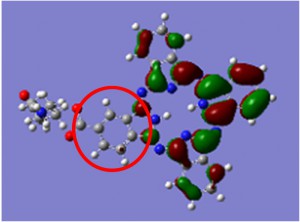[Published online Journal of Computer Chemistry, Japan Vol.16, 141-143, by J-STAGE]
<Title:> ナイロン6様分子をフタロシアニン類に混入した系における電子状態の考察
<Author(s):> 成島 和男, 池永 祐乙, 光井 和輝
<Corresponding author E-Mill:> narushim(at)ube-k.ac.jp
<Abstract:> Since the appearance of bulk heterostructures, organic thin film solar cells have attracted attention as next-generation energy sources. Earlier studies have addressed quantum chemical calculation in an excited state and a ground state of phthalocyanine fullerene bimolecular systems. Phthalocyanines and fullerenes are well known as materials of organic thin film solar cells. Based on these reports, we have devised a new method of manufacturing organic thin film solar cells and have prepared a device incorporating those features. Nevertheless, the device is so soft that it is considered necessary to strengthen the device by incorporating a fibrous substance. This study investigated the effects on its electronic properties of incorporating molecules like nylon 6 into phthalocyanine using quantum chemical calculation. Results demonstrate partial defects in the electron cloud of phthalocyanine molecules, revealing the occurrence of positive holes. These electron cloud defects result from interaction between nylon dimer molecules and phthalocyanine molecules.
<Keywords:> キーワード:Organic thin Film Solar Cell, Molecular Orbital Method, Phthalocyanine, Nylon 6, Charge Density
<URL:> https://www.jstage.jst.go.jp/article/jccj/16/5/16_2017-0063/_html/-char/ja/
<Title:> ナイロン6様分子をフタロシアニン類に混入した系における電子状態の考察
<Author(s):> 成島 和男, 池永 祐乙, 光井 和輝
<Corresponding author E-Mill:> narushim(at)ube-k.ac.jp
<Abstract:> Since the appearance of bulk heterostructures, organic thin film solar cells have attracted attention as next-generation energy sources. Earlier studies have addressed quantum chemical calculation in an excited state and a ground state of phthalocyanine fullerene bimolecular systems. Phthalocyanines and fullerenes are well known as materials of organic thin film solar cells. Based on these reports, we have devised a new method of manufacturing organic thin film solar cells and have prepared a device incorporating those features. Nevertheless, the device is so soft that it is considered necessary to strengthen the device by incorporating a fibrous substance. This study investigated the effects on its electronic properties of incorporating molecules like nylon 6 into phthalocyanine using quantum chemical calculation. Results demonstrate partial defects in the electron cloud of phthalocyanine molecules, revealing the occurrence of positive holes. These electron cloud defects result from interaction between nylon dimer molecules and phthalocyanine molecules.
<Keywords:> キーワード:Organic thin Film Solar Cell, Molecular Orbital Method, Phthalocyanine, Nylon 6, Charge Density
<URL:> https://www.jstage.jst.go.jp/article/jccj/16/5/16_2017-0063/_html/-char/ja/
